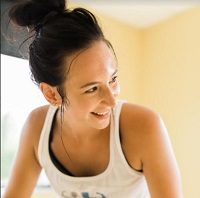![]()
Further reading: When it’s Not your Body, but your Soul that’s Tired.
More like this:
10 Things Your Massage Therapist Wants You to Know.
How to Know if our Body is Carrying Subconscious Anger, Pain & Trauma.
“You have the wrong body for Ballet.”
We’ve all heard it before: comparison is the thief of joy.
A simple concept that is so easily forgotten. When we fall into comparison, we tend to compare our current bloopers to another’s highlight reel. We compare the aspects that we deem “Need Improvement” to something that “Exceeds Expectations.” When we base our actions and thoughts off of what something looks like, we are always setting ourselves up for disappointment. Comparison truly is a thief of joy, contentment, and self-love.
Think of a time in your life when you felt your best in your body; felt the most comfortable in your skin. More likely than not, whether it was six months ago or 15 years ago, that time is associated with a number. The number that showed when you stepped on the scale, however many years ago, and you felt the best about it.
And now, as we look in the mirror or see a photo we deem as “unflattering,” a little voice in our head says, “If you could just get back to that number on the scale again, you’d be happier.” Or, “If you could get back to that body again things would be better.” We then set off, using whatever means necessary, envisioning the moment when we look in the mirror and see our 15-year-old body, or our 22-year-old body, or our 35-year-old body.
Here’s an unpopular opinion—an idea we may not like: we will never have the same body twice. We will never look in the mirror and see our 15, 23, or 35-year-old body. Ever again. That’s not to say that we can’t reach that particular number on the scale, but it is to say that even if we do see that number on the scale, and we look in the mirror, our bodies will not look as they did then.
Here’s what I know: I have gained weight, then lost it. Gained a little, then lost a little. Gained a little more, then lost a little more. Through all that time and through all those transitions, I’ve never looked in the mirror and saw the same body twice, regardless of what the scale was telling me. I’ve seen the same number on the scale at least five times in the last five years, and it’s visually looked different every single time.
Here’s why this happens: our bodies have a certain percentage of lean body mass, or muscle. On top of the muscle is fat. The amount of lean body mass we have, plus the amount of fat we have, plus some organs and important water stuff, equals our scale weight. The visual composition of our body is dependent on how much muscle we have and where the fat is distributed within the body. If weight is gained or lost, the amount of lean muscle mass is going to change as well, which means the fat that we have gets redistributed. When the fat is redistributed, it will visually look different, because the amount of lean muscle mass is different.
Basically, all that science-y crap means is that one specific time you saw that particular number on the scale, that scale weight was made up of a very specific amount of muscle and fat. It is very unlikely you will ever see that very specific composition again. Meaning, you will never look in the mirror and see the same exact body composition twice. Meaning, you should stop comparing your “today” body to your “then” body.
Men chasing after their “18-year-old self” six-pack, stop. A six-pack can be obtained, but the process to get there and the end result will look different. Using what worked then is negatively impacting your results now.
Mamas trying to “bounce back” from your last baby, stop. You internal organs literally shifted, and you grew a tiny human inside of you. That’s rad. Your body can’t go back to the way it was because you’ve not only made space for a new little person, but your personal growth has filled in those spaces.
Anyone trying to “get your body back” after many years of “letting yourself go,” stop. You’ve learned so much in this time, you shouldn’t be “going back,” there is nothing for you back there.
Instead of focusing on what was or how something looked in the past, let’s change the narrative. How can we become the best versions of our current selves? Not a second edition of an outdated self. Going one step further, let’s ask ourselves, “What would the best current version of me feel like?” Notice how I didn’t ask, “What would the best current version of me look like?”
We are always changing, always learning, always becoming better. We wouldn’t trade what we know now for what we knew then. We are always moving forward, and so should our bodies.
~










Read 71 comments and reply